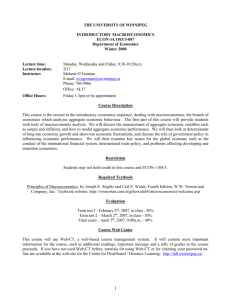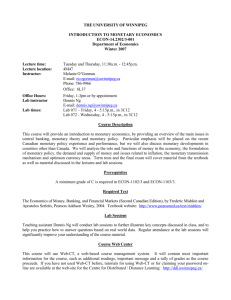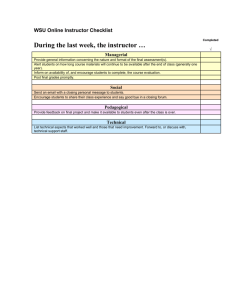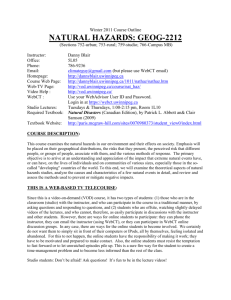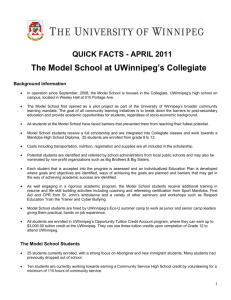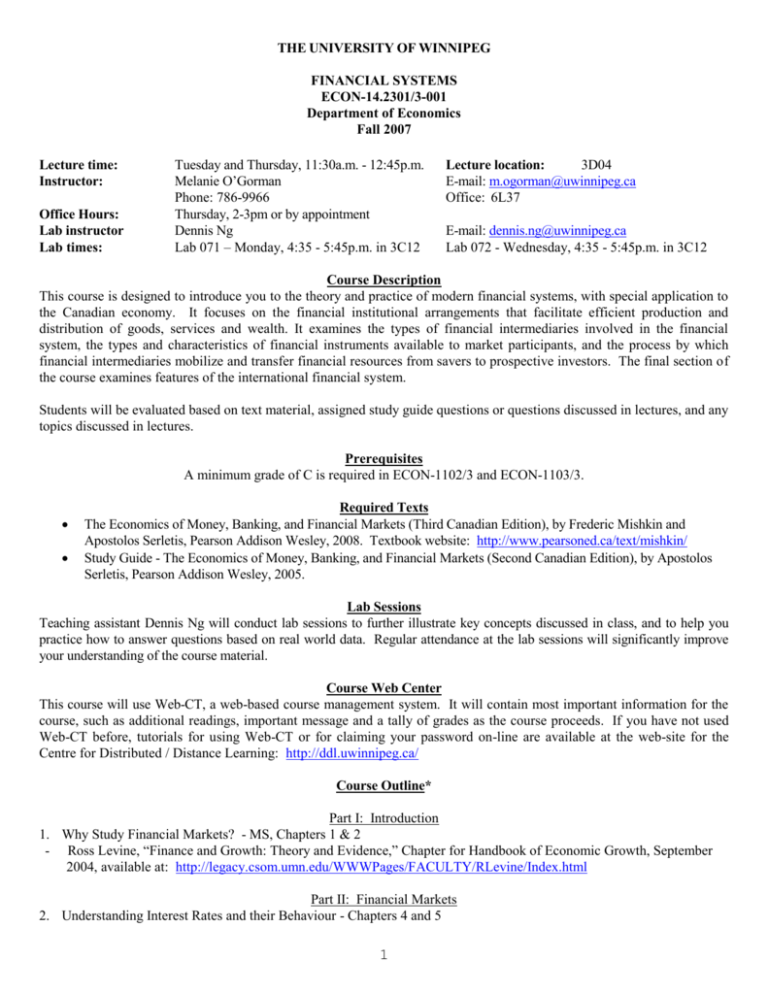
THE UNIVERSITY OF WINNIPEG
FINANCIAL SYSTEMS
ECON-14.2301/3-001
Department of Economics
Fall 2007
Lecture time:
Instructor:
Office Hours:
Lab instructor
Lab times:
Tuesday and Thursday, 11:30a.m. - 12:45p.m.
Melanie O’Gorman
Phone: 786-9966
Thursday, 2-3pm or by appointment
Dennis Ng
Lab 071 – Monday, 4:35 - 5:45p.m. in 3C12
Lecture location:
3D04
E-mail: m.ogorman@uwinnipeg.ca
Office: 6L37
E-mail: dennis.ng@uwinnipeg.ca
Lab 072 - Wednesday, 4:35 - 5:45p.m. in 3C12
Course Description
This course is designed to introduce you to the theory and practice of modern financial systems, with special application to
the Canadian economy. It focuses on the financial institutional arrangements that facilitate efficient production and
distribution of goods, services and wealth. It examines the types of financial intermediaries involved in the financial
system, the types and characteristics of financial instruments available to market participants, and the process by which
financial intermediaries mobilize and transfer financial resources from savers to prospective investors. The final section of
the course examines features of the international financial system.
Students will be evaluated based on text material, assigned study guide questions or questions discussed in lectures, and any
topics discussed in lectures.
Prerequisites
A minimum grade of C is required in ECON-1102/3 and ECON-1103/3.
Required Texts
The Economics of Money, Banking, and Financial Markets (Third Canadian Edition), by Frederic Mishkin and
Apostolos Serletis, Pearson Addison Wesley, 2008. Textbook website: http://www.pearsoned.ca/text/mishkin/
Study Guide - The Economics of Money, Banking, and Financial Markets (Second Canadian Edition), by Apostolos
Serletis, Pearson Addison Wesley, 2005.
Lab Sessions
Teaching assistant Dennis Ng will conduct lab sessions to further illustrate key concepts discussed in class, and to help you
practice how to answer questions based on real world data. Regular attendance at the lab sessions will significantly improve
your understanding of the course material.
Course Web Center
This course will use Web-CT, a web-based course management system. It will contain most important information for the
course, such as additional readings, important message and a tally of grades as the course proceeds. If you have not used
Web-CT before, tutorials for using Web-CT or for claiming your password on-line are available at the web-site for the
Centre for Distributed / Distance Learning: http://ddl.uwinnipeg.ca/
Course Outline*
Part I: Introduction
1. Why Study Financial Markets? - MS, Chapters 1 & 2
- Ross Levine, “Finance and Growth: Theory and Evidence,” Chapter for Handbook of Economic Growth, September
2004, available at: http://legacy.csom.umn.edu/WWWPages/FACULTY/RLevine/Index.html
Part II: Financial Markets
2. Understanding Interest Rates and their Behaviour - Chapters 4 and 5
1
3. The Risk and Term Structure of Interest Rates - Chapter 6
4. The Stock Market, the Theory of Rational Expectations, and the Efficient Markets Hypothesis - Chapter 7
5.
6.
7.
8.
Part III: Financial Institutions
An Economic Analysis of Financial Structure - Chapter 8
Banking and the Management of Financial Institutions – Chapter 9
Banking Industry: Structure and Competition – Chapter 10
Non-bank Finance - Lecture notes
Part IV: International Finance
9. The Foreign Exchange Market - Chapter 19
- C. Fred Bergsten, “The Dollar and the Renminbi”, Peterson Institute,
http://www.iie.com/publications/papers/paper.cfm?ResearchID=747
10. The International Financial System - Chapter 20
11. Global Financial Integration – online lecture notes
12. Microfinance – online lecture notes
*Due to time constraints, all topics listed may not be covered
Assignment
Students will be required to write a 6-12 page (double-spaced) reflection on a topic related to the analysis of financial systems,
but outside the standard theory of this course. Suggested topics are posted on WebCT. You are free to choose your own topic
but please confirm it with the instructor early in the semester.
Evaluation
Term test 1 – September 27th, 2007, in class - 20%
Term test 2 – October 23rd, 2007, in class - 20%
Assignment – Due November 22nd, 2007, in class – 30%
Final exam – December 13th, 2007, location to be announced - 9a.m. - 30%
Grading Scheme
<50 F; 50-59 D; 60-64 C; 65-69 C+; 70-74 B; 75-79 B+; 80-84 A-; 85-92 A; 93-100 A+
Important Notices
1. It is your responsibility to be familiar with the information on Academic Regulations and Policies, Section VII of the
2007-08 Campus Guide, pages 116 - 125.
2. Voluntary withdrawal – If you choose to withdraw from this course, you must formally withdraw. If you simply stop
going to classes, you may receive an “F” on your transcript and loss of tuition credit. Please refer to the 2007/08
Calendar for Voluntary withdrawal procedures (p. 42). The deadline for voluntary withdrawal for this course is Oct. 30,
2007.
3. Services for Students with Disabilities - Students with documented disabilities requiring academic accommodations for
tests/exams (e.g., private space) or during lectures/laboratories (e.g., access to volunteer note-takers) are encouraged to
contact the Coordinator of Disability Services (DS) at 786-9771 to discuss options. Specific information about DS is
available on-line at http://www.uwinnipeg,ca/index/services-disability. All information about disability is confidential.
4. Final grades are subject to University Senate review.
5. Students will not be permitted to write make-up tests or hand in assignments late, except for documented medical or
compassionate reasons. If a student misses a term test, an official document must be given to the instructor, justifying
the absence, and the weight of that test will be added to the final exam weight. If no documentation is given, a grade of
zero will be awarded.
6. During tests and the final exam, only basic calculators will be permitted (i.e. calculators without any memory). All
tests will be closed book tests. Student identification cards may be requested during tests. Paper dictionaries are
permitted during tests for the purposes of translation but they must be examined by the instructor prior to the test.
2

